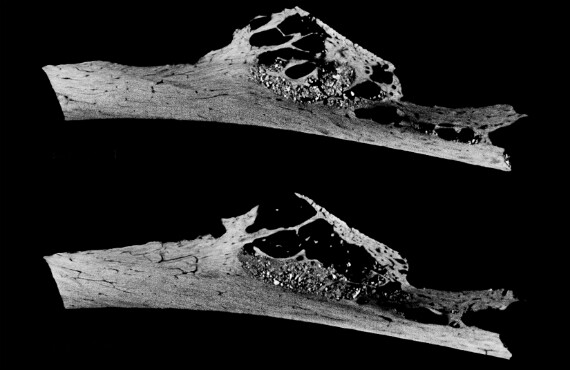Penn Research Identifies Bone Tumor in 120,000-Year-Old Neandertal Rib
The first-known definitive case of a benign bone tumor has been discovered in the rib of a young Neandertal who lived about 120,000 years ago in what is now present-day Croatia. The bone fragment, which comes from the famous archaeological cave site of Krapina, contains by far the earliest bone tumor ever identified in the archaeological record. Details of the tumor confirmation, announced by an international research team led by Penn Museum Associate Curator and Paleoanthropologist Janet Monge, is available in a research paper, “Fibrous dysplasia in a 120,000+ year old Neandertal from Krapina, Croatia,” in the online scientific journal PLOS ONE.
Joining Dr. Monge on the research team were Morrie Kricun, Department of Radiology, University of Pennsylvania; Jakov Radovcic and Davorka Radovcic, Croatian Natural History Museum; Alan Mann, Department of Anthropology, Princeton University, and David Frayer, Department of Anthropology, University of Kansas.
Bone tumors are exceptionally rare finds in the evolutionary fossil and archaeological records of human prehistory, with the earliest known instances, before now, dating to 1,000 to 4,000 years ago. Primary bone tumors are rare in modern populations, thus, finding a tumor in a fossil so old is a unique discovery.
From a u-CT scan and an X-ray, researchers identified a fibrous dysplastic neoplasm—today, the most common form of benign bone tumor in humans—located on a Neandertal left rib fragment that measured 30 mm (4 ½ inches) long. Judging by the size of the rib fragment, at the end of the rib that joins to the vertebrae, the rib belonged to a young male Neandertal, probably in his teens. Though he died young, and fibrous displasia is a developmental disorder of bone, there are no other known fossils that can be attributed to this individual, and there is not enough evidence to determine if this was or contributed to the cause of his death, according to Dr. Monge.
The confirmation of this tumor, Dr. Monge believes, may have implications for scholars studying the relationship between Neandertals and modern humans. “This tumor may provide another link between Neandertals and modern peoples, links currently being reinforced with genetic and archaeological evidence. Part of our ancestry is indeed with Neandertals—we grow the same way in our bones and teeth and share the same diseases.”
Paleoanthropologists continue to debate the exact relationship between homo sapiens, or humans today, and Neandertals—an extinct species who lived throughout Eurasia from as early as 600,000 years to as late as 30,000 years ago. One of the most important early Neandertal sites was discovered in modern-day Croatia in 1899, when Dragutin Gorjanovic-Kramberger, Director of the Geology and Paleontology Department of the National Museum and Professor of Paleontology and Geology at Zagreb University, alerted by a local schoolteacher, first visited the Krapina cave and noted cave deposits, including a chipped stone tool, bits of animal bones, and a single human molar. Beginning that year, and continuing through six years, Gorjanovic-Kramberger and his associates completely, and for that era, carefully, excavated the cave. By 1905, Krapina had yielded more hominid remains than any other site known at the time.
Click here to view the full release.








